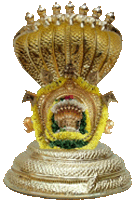Kukke Subrahmanya is on the bank of river Dhara. According to Hindu Mythology Lord Kumaraswamy came to this place after killing the demon rulers  Taraka, Shoorapadmasura and others in a war; and the Lord washed his Shakthi Ayudha (a battle-ax of the type of a bayonet) in this river. From this onwards the river is famous as Kumaradhara.
Taraka, Shoorapadmasura and others in a war; and the Lord washed his Shakthi Ayudha (a battle-ax of the type of a bayonet) in this river. From this onwards the river is famous as Kumaradhara.
After battle with the demon, Lord Kumaraswamy came to the top of Kumaraparvatha along with his brothers Lord Ganesha, Veerabahu and other aids. He was received by Lord Indra along with other Gods; pleased by the success of the war Indra prayed the Lord to be Kind enough to marry his daughter Devasena. This was agreed upon courteously and the marriage took place on the banks of Kumaradhara on ‘Margashira Shuddha Shashti’ (The shashti is on the first half of Margashira Masa.) Lord kumaraswamy also gave a darshan to Vasuki, the head of the Nagas, who was making a penance here. Vasuki prayed the Lord to stay along with him permanently in the place and the Lord blessed Vasuki with the boon.
From that time it a believed that the Lord has made his spiritual presence in this shrine along with his wife Devasena and Vasuki. Every year a famous car festival (Champa Shashti) is being held here on ‘Margashira Shuddha Shashti’ with special poojas to the Lord.
According to one more Mythology, after killing the demon rulers, Tharaka, Shurapadmasura and their followers in a war, Lord Shanmuka reached Kumara parvatha with his brother Ganesh and others. He was received by Indra and his followers. Indra being very happy prayed Lord Kumara swamy to accept and marry his daughter Devasena for which the Lord readily agreed. The divine marriage took place on Margashira shudha shashti at Kumara parvatha. Gods like Brahma, Vishnu, Rudra and many other deities assembled for the marriage and coronation ceremony of Shanmukha for which waters of several holy rivers were brought. With these waters of Mahabhisheka fell down to form a river which was later known by the popular name Kumaradhara.
The great Shiva Bhakta and Serpent king Vasuki was performing tapas for years in the Biladwara caves of Kukke Subrahmanya to avoid the attack of Garuda. Following Lord Shiva’s assurance Shanmuka gave darshan to Vasuki and blessed him that he would stay with his parama bhakta in this place forever.
Hence the poojas offered to Vasuki or Nagaraja are nothing but the poojas to Lord Subrahmanya.